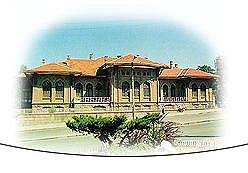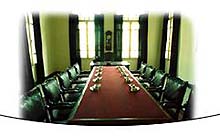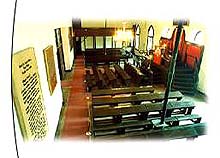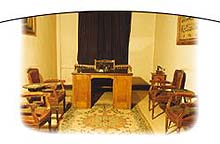Ankara - Independence War Museum (1stTurkish Grand National Assembly Building)
History of the Building
 The building is located in Ulus Square, Ankara. Initially it was planned as the Committee of Union and Progress Party building and designed by the pious foundation's architect Salim Bey and the construction, which started in 1915, was supervised by the Army Corps architect Hasip Bey.
The building is located in Ulus Square, Ankara. Initially it was planned as the Committee of Union and Progress Party building and designed by the pious foundation's architect Salim Bey and the construction, which started in 1915, was supervised by the Army Corps architect Hasip Bey.
The two-storey building is in Turkish architectural style and its most prominent characteristic is the use of Ankara stone (andesite) in its masonry walls.
When the decision was given to gather the National Assembly in this building on 23 April 1920, the construction was not yet complete. It was completed as a result of the enthusiasm and contributions of the people.
The building functioned as the I. Turkish Grand National Assembly between 23 April 1920 and 15 October 1924. Later, it was used as People's Republican Party headquarters and Law School. In 1952 it was transferred to the Ministry of Education and restoration works started in 1957 to convert the building for a museum. It was opened to public as the Turkish Grand National Assembly Museum in 23 April 1961.
In the beginning of 1981, the new restoration and refurbishment work started by the Antiquities and Museums General Directorate of the Ministry of Culture and Tourism within the programme of Atatürk's centenary birth celebrations. The building reopened to the public as the Independence War Museum on 23 April 1981.
Opening of the I. Turkish Grand National Assembly
Crowds of thousands of people gathered around the building for the opening of Assembly on 23 April 1920. After the ceremonies the Assembly had its first meeting with 115 representatives. The first speech was made by the President of the Assembly, elected for being the oldest member, Sinop representative Serif Bey.
“Honourable members of the Assembly,
It is well known that the Capitol of Caliphate and the Government has been occupied in temporary terms by the enemy forces and our independence has been restricted in every respect. Submission to these conditions means acceptance of captivity imposed by the foreign powers. However, eternally free and an independent nation of ours, determined to exist in absolute independence, rejected this captivity with final determination and by gathering its representatives, brought into being this Grand Assembly of ours. In the name of the speaker of the Grand Assembly and by the help of God, I declare the principals of absolute independence and self determination of the nation to the whole world and open the National Assembly.”
After this opening speech, Ankara representative Mustafa Kemal had his turn to speak and explained the method implemented for the election of members to form the assembly:
“As you all know, our Grand Assembly is constituted by the re-elected honourable members charged with extraordinary powers and honourable members fleeing from the Government Capital which was attacked and occupied. The constitution of this Grand Assembly was made possible only by the new election system, which included those who were able to flee from the capital and join us. Presently your Assembly is meeting with all legalities.”
The second session of the Assembly held on 24 April 1920 and Mustafa Kemal unanimously elected as the President of the Assembly.
Mustafa Kemal made a lengthy and significant speech in this meeting. Saying, “There is no power above this Grand Assembly anymore...” indicated the importance of this Assembly.
Independence War concluded by the successful leadership of Gazi Mustafa Kemal and the decisions taken in the First Turkish Grand National Assembly. Among those decisions are, approval of the First Constitution on 20 January 1921, approval of the National Anthem on 12 March 1921 and abolishing of Sultanate on 1 November 1922. Approval of Lausanne Peace Treaty on 24 July 1923, establishing Ankara as the Capital City of the Turkish Republic on 13 October 1923, Declaration of Republic and the election of Gazi Mustafa Kemal as the First President of the Republic on 29 October 1923, are also taken place in this Assembly.
In one of his speeches, Atatürk saying, “The Grand National Assembly is the living symbol of the Turkish Nation's century’s old search for self determination and consciousness...” pointed the significance of the Grand National Assembly.
Sections of the Building
Corridor
On the left side of the corridor and in the rooms opening to it, the events between the years 1918 - 1923 are recounted in chronological order by oil paintings, photographs, documents, various items, and models of war weapons, tools and equipments.
On the right side of the corridor and in the rooms opening to it, work of the Assembly sessions, photographs of representatives from the first and the second term of the Assembly, oil paintings, documents, memorials and various items are displayed.
Presidential Board - Cabinet Room 
The first room on the left side of the corridor. This room had been used as the Cabinet Room and as well as the Presidential Board room. The President’s pulpit used in Sivas Congress,the cabinet table and chairs, and photographs of the members of the First Cabinet after the declaration of the Republic are in display in this room. Original appearance and arrangement of the room is preserved.
Committee Room
The second room on the left side of the corridor. The room used as the Committee Room to study and investigate various subjects related to the issues at hand in the Assembly. In this room, the facts about Moudros Armistice Agreement, Mustafa Kemal’s arrival in Samsun, Amasya Circular, Erzurum and Sivas Congresses, and the National Pact are introduced by documents, photographs and various items. The most valued item on display in this room is the seal used in Erzurum Congress.
Lounge Room (Lobby)
The third room on the left side of the corridor was used as the Assembly Lobby. There is an oil paint depicting Mustafa Kemal's arrival in Ankara. Opening of the Assembly, terms of Sevres and Lausanne Agreements in relation to Türkiye, and I. And II. Battles of Inönü are introduced by photographs, documents and maps. Also the telephone switchboard used during the Independence War, some weapons and other various items and a silver cutlery set presented to Kazim Karabekir Pasha at the Gümrü Agreement Ceremony are on display in this room.
Legislative Committee Room
The fourth room on the left side of the corridor.The Committees investigated the accordance of the bills with the Constitution in this room. The Great Offensive, the last stage of the Independence War, is introduced by photographs, documents and maps. Also there are, a rug symbolizing the National Pact, Independence War, medals and an oil painting depicting Gazi Mustafa Kemal and his friends on the balcony of the Assembly Building.
Administration Room
The fifth room on the left side of the corridor used as the administrative office National Anthem, the photographs of the commanders who took part in the Independence War, documents of Mudanya Armistice and Lausanne Agreement, establishing Ankara as the Capital City, declaration of Republic, Mustafa Kemal’s first speech in the Assembly after elected as the President of the Republic and his photograph on this occasion. Mustafa Kemal’s cane, Mauser rifle, seals, field glasses he used in the Independence War, samples of uniforms, the flag hoisted onto the Grand National Assembly on 23 April 1920 with Recep Peker’s signature and a cloth with inscriptions presented to the Grand National Assembly by the Women’s Charity Society, are introduced and displayed in this room.
Administration Rooms
The fifth and the sixth room on the right side of the corridor were both used as the Administrative rooms of the Assembly. Again today the sixth room is used as the Administrative Office of the Museum. In the fifth room, photographs and identity cards of the first and second term members of the Assembly, Mauser rifles given to the members by the Turkish Grand National Assembly, Independence War Medals, badges, documents and personal souvenirs are on display.
 Grand Assembly Hall
Grand Assembly Hall
The Assembly Hall is located on the right side of the corridor. The original configuration is preserved in this hall. In the middle the Assembly President’s and the Chair Councils pulpit is located, and behind it the inscription in the old alphabet says, “Sovereignty belongs to the Nation.” Cabinet members sit across the pulpit, side rows belongs to representatives, the diplomatic corps sit on the right side mezzanine while the audiences sit on the left side mezzanine. Space under the side of the mezzanine is alloted to local and foreign press agents and staff.
The pulpit used when the Assembly gathered on 23 April 1920 in this hall, was made and presented by a carpenter of Ankara, rows were taken from the Ankara Teachers’ Schools’ classes, the two kerosene lamps and the stoves were taken from the neighbouring coffee houses, office materials were brought from the government offices. The foundation of the first Assembly building, based on Sovereignty of the Nation was laid down in this building with the aid of its people.
Masjid
The first room on the right of the Museum entrance. In this simply decorated room some prayer rugs and Koran Rahle’s (low reading book rest) are on display.
The Assembly President’s Room 
The second room on the right and also the study room of Mustafa Kemal in the Assembly Building. The original state of the room is preserved and displayed as it is.
Many important decisions were taken in this simply decorated room. The Presidential seal, which is put on display on the occasion of National Days time to time, is the most important and distinguished piece of this museum.
Basement Floor
This floor is presently being used as the exhibition gallery, for storage and as the photograph laboratory.